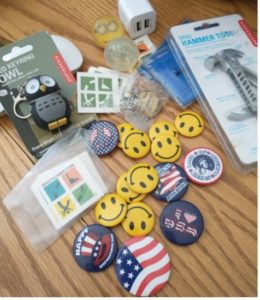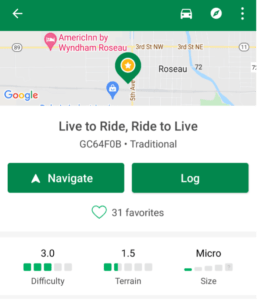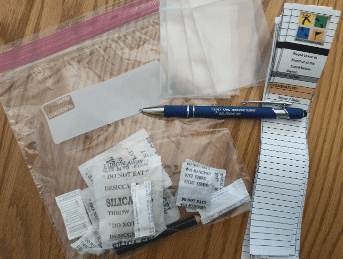Geocaching, one of the MANY outdoor activities available in Roseau County
There are 52 active geocaches in Roseau County as of April 2022, and over 28,000 in the State of Minnesota!
Geocaching originated in 2001 when satellites became publicly accessible. At that time, we had no idea how much satellite access would change our lives. Nearly all of us are familiar with mapping programs and driving directions, traffic included, on our devices. Another, more fun, use of that technology is Geocaching! Using GPS coordinates located in a phone app, or handheld GPS, you can find “Tupperware hidden in the woods”. While sometimes the “cache” itself is amazing, more often it’s the location or search experience that people enjoy.
WARNING SPOILER ALERT IN THE VIDEO BELOW
I’m Yvonne Wensloff and I started my geocaching adventures in 2006. Some years I have spent days searching for these little gems, and other years life was too busy. I’ve found nearly 1,600 – with the last 700+ with my husband. We geocached on our first date, and he’s been hooked ever since!! It’s a great group, or family, an activity that allows for conversation, exercise, new discoveries, and a shared challenge. The largest expense involved is transportation to an area where they are geocaches, but chances are you can start in your own neighborhood!! To begin your geocaching adventure, first visit www.geocaching.com to register for a user name (finder name) and watch the videos, or read about various adventures. There is much more to it than meets to eye; it goes far beyond the scope of this article! The phone app is free for both Android and IOS. Just search for “Geocaching” and pick the one with the green square logo by Groundspeak. There are other apps but this one is excellent for beginners as it coaches you through the process when you start. But first, you need to learn the basics.
On either the website or the phone app, you can bring up a map that will populate with a little green circle with an ammo can symbol… for most of them. There are different types of caches, which I encourage you to research on the website, or in the app, to familiarize yourself with the different types. DO start with the green ammo can or blue envelope types though!! There are TWENTY different kinds of geocaches designated by “type” of cache definitions, so it’s prohibitive to cover here. Other types include Earth Caches, Event Caches, Puzzle or Mystery caches, all of which do not have a container to find at the posted GPS coordinates! This is why is it critical to understand types of geocaches and how they show on the map. You may want to search for an ”event cache” in your area, where you can meet other geocachers to get more tips and make some new friends if you’re so inclined.
This is not just a United States thing, although it started in Seattle Washington. Many geocaches take you to surprising locations where you see the coolest stuff on earth!
Container and Search Basics:
People often envision a treasure chest with loot when we’re talking about finding a cache, but more often it’s an ammo can or plastic container! But yes, you will find caches with “loot” in them, called SWAG by geocachers. The rule of thumb is that if you take something you need to replace it with something of similar value, to keep paying it forward for future finders to enjoy. Kids especially like the caches that are large enough to contain some kind of prizes. Food and non-child friendly themed items are not allowed. Food tends to cause a cache to be destroyed because an animal will smell any kind of food. We rotate the SWAG we trade, rubber balls and pins are in stock right now… tattoos, a charger, small tools, etc.

Geocaches are classified by three different aspects. One is size of container, SWAG is most common in the “regular” or large size container, and others can be way too small to hold anything but the signature log! Other published aspects of a geocache are difficulty of the find/hide and the terrain rating. This gives the geocacher the ability to restrict the physical challenge level and have some idea what they are looking for. When starting out it is wise, and more fun, to target the caches with a maximum of a 2 difficulty and 2 terrain. You want to find a few to cultivate your abilities. Larger containers are usually easier to find as well. But even some big caches are so cleverly hidden that you may have walked right by one without knowing it!! Here is an example of the classifications displayed in the Geocaching app for each geocache. This cache is the most “favorited” cache in the City of Roseau and is quite difficult to find although you can walk right up to it! This is shown by the difficulty rating of 3/5 and the terrain rating of 1.5/5 – ALL terrain 1 geocaches must be wheelchair accessible. So a ton of 1.5 terrain geocaches exist and are the easiest to physically access.

This size on this one is “micro” which will fit in the palm of your hand, or could be TINY.. think the size of a pencil eraser! The description will usually use the term Nano if it’s the smallest of Micro sized. A Regular or Large can be an entire small building!! Paying attention to what size of a geocache you are looking for is key. Some are also ‘evil’ or so well disguised that they may be hidden in plain sight. These are the one’s that drive people mad! You may or may not enjoy that level of search so you may want to avoid anything over a 2.5 or 3 difficulty to avoid the dreaded “did not find” (DNF) which you are also encouraged to log. Us cache owners want to know if people are unable to find our caches!! When someone logs that they couldn’t find one of ours, I look to see if others have had problems, or how experienced is the cacher is that logged the DNF. We will provide additional hints or change the description, or possibly even increase the difficulty rating if many people are unable to find a particular geocache. A few of our Roseau County caches are very difficult… but also result in a major sense of victory when found.

One Final Thing Before You Start!!
You will want to carry a pen/pencil and a tweezer with you at all times. In the smaller containers the paper log is often difficult to extract and return to the container after you sign it, making the tweezer a handy tool! Please note that the rule is that you must sign the paper log to claim the find. Some CO’s (cache owners) DO check logs when they replace them with new pages to verify signatures, especially for very difficult rated caches. Just because you see one hanging in that tree does not make it found!! You have to actually retrieve, sign and replace the container where you found it.
We carry a tactical bag with basic supplies and tools that we have found useful over the years. You don’t need to have anything but a writing instrument, a way to get to the cache, and possibly tweezers to start. If you become ‘serious’ about Geocaching, you may want to pickup some blank logs, small baggies, save your silica packs to place in damp caches, etc. We carry a ‘maintenance kit’ with us wherever we go, and have our bag of tools in the car. Our tools include a magnetic pole, a ladder, a spring loaded parts grabber, a flashlight, headlights, a leather glove (I need to put my hand where?!?!) and a first aid kit.

The only expense that I’d recommend right from the start is a “premium membership” to the app once you’ve decided this is something you want to do for the next year. There are some caches that are hidden in the app as “premium only” and this is done especially for caches where the owner has invested significant effort, money or time in creating the cache. There are also caches that are well suited and published for “travel bugs”. These are coins or trinkets that usually have a tag attached, or are in a baggie, with instructions as to an objective, such as visit all 50 states, that has a tracking number. This is just one of the bonus aspects of geocaching you should be aware of… if you take one of these travel bugs from a cache, PLEASE make sure that you log it and then take it to a different cache to be found again. Geocachers pay $5-$30 for these travel bugs and many of us enjoy this aspect of the hobby.
My husband and I go by the cacher ID of YsOnes. If you are searching in the Roseau area, you can use the built in message feature in the app to contact the (geo) cache owner (CO), or us even if it’s not ours, for a clue if you’re struggling or have a problem. Most cache owners are more than happy to assist other geocachers.
Please do visit www.geocaching.com to learn more about this exciting adventure based hobby.
